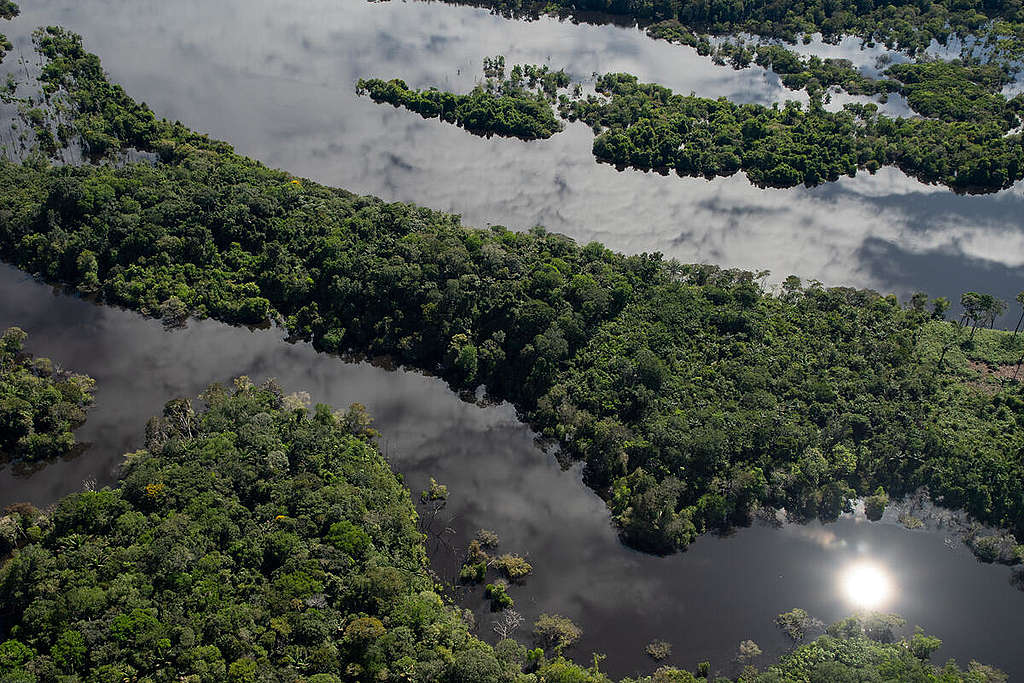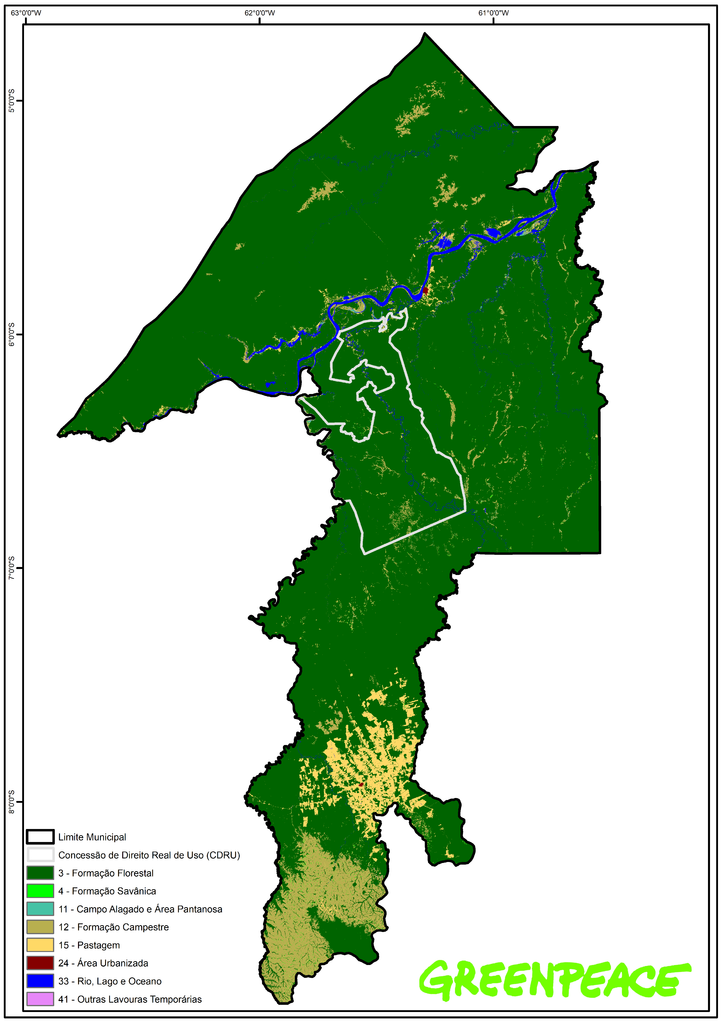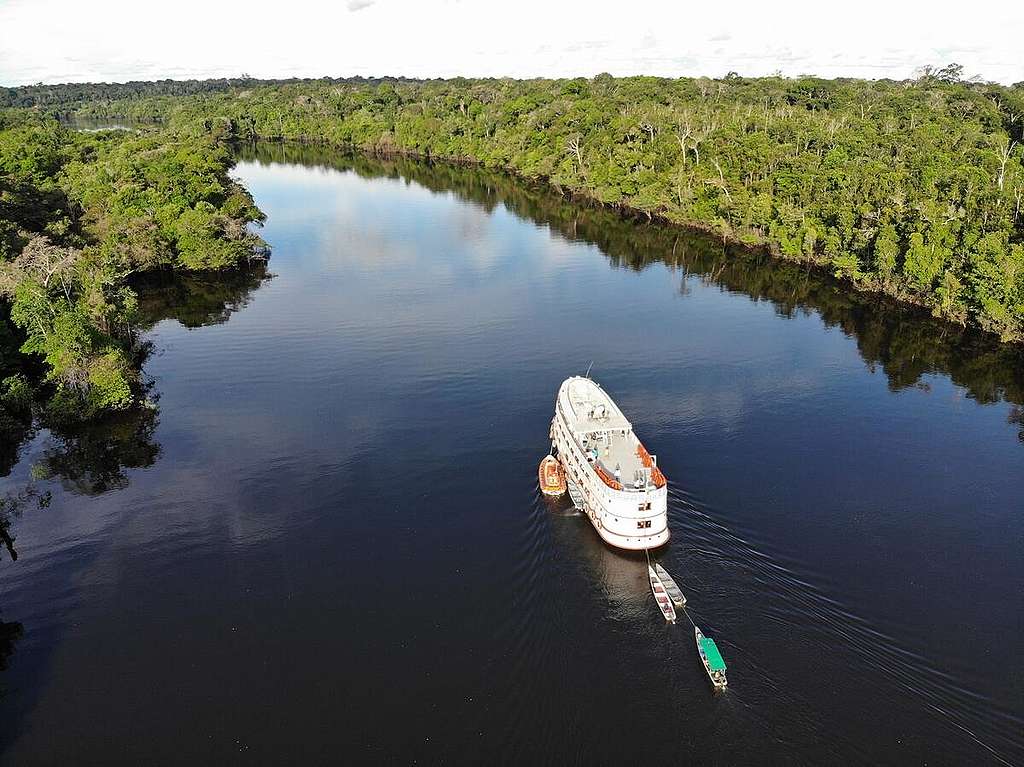This article originally appeared on Greenpeace Brazil’s website.
The Amazon is an ancient forest, home to incredible animals and unknown species. Indigenous Peoples, traditional communities, and environmental activists are among those who are working to protect it amid grave dangers. It can feel cinematic at times, but it is real life.

In the south of the Brazilian state of Amazonas, very close to where columns of trees meet pasture fences, a coffee-colored river meanders through a living and pulsating forest. Our story begins there, where thousands of people struggle to secure a thriving future for their piece of Amazônia, and nature is mother of this resistance.
Just beyond a frontier of forest destruction, the Manicoré region is located in the “AMACRO region,” where the states of Amazonas, Rondônia and Acre converge. The Manicoré region takes its name from the Manicoré River — a tributary of the Madeira River, the biggest tributary of the Amazon — that crosses through the heart of the area. Since 2015, Manicoré has been the fifth-most deforested region in the state. In the last year alone, 134.67 square kilometers (km²) were deforested there.
The Economy of Destruction and Danger
The threats to the forest and the communities who call it home have become ever present. While in the north of Manicoré, gigantic rafts of mining machinery are spread by the hundreds along the rivers, contaminating the waters and the fish. Further South, the forest is being rapidly stolen and destroyed by illegal loggers, land grabbers, and cattle ranchers.

These intersecting processes of forest destruction are made possible by an intentional strategy of the Bolsonaro government to sabotage environmental law enforcement, weaken laws, and offer leniency to land grabbers and others involved in environmental crimes. The future of the Amazon rainforest has been put up for sale by those who value profits over people and the planet. Unless the forest is protected, companies and politicians will try to profit until the last leaf.
This government’s anti-environmental policies also increase violence in the region against traditional communities and Indigenous Peoples, as well as activists, inspectors, and professionals who dare to speak the truth about this absurd situation. The world saw a tragic example of what can happen in such an atmosphere of lawlessness with the murders of Brazilian Indigenist Bruno Pereira and English journalist Dom Phillips earlier this month.
The destructive economic development model long practiced in the Amazon has been bolstered by the Bolsonaro government. It does not have to be this way. Local communities have been living in harmony with the forest. They understand sustainable uses of the standing forest — such as açai fruit cultivation or harvesting of Brazil nuts. Ensuring the rights of communities that want to live with the forest sustainably is a necessary way forward because the Amazon rainforest will not exist in the future if mining, burning, or forest destruction continues.
We don’t really have much of a choice, there are climate and biodiversity emergencies knocking at our door, and the destruction of the Amazon only accelerates them. If the Amazon rainforest reaches a tipping point of no return, the Amazon will fail as a rainforest and there will be impacts for all of us. Many people already understand this, and are advocating for sustainable development models that understand the science and recognize what is at stake. Without protecting the Amazon, we can lose it — and so much more — altogether.
The future of Manicoré — and the Amazon
In Rio Manicoré, a group of communities, home to about 4,000 people, have been fighting for 16 years for the creation of a Sustainable Development Reserve (RDS), a type of protected area that exists in Brazil that is designed to protect natural areas of great biological relevance, while also guaranteeing the sustainable use of natural resources by traditional populations, ensuring their way of life.
Over the years, the communities associated with the Central das Associações Agroextrativistas do Rio Manicoré (Caarim) have sought to prove the necessity of having their forest protected. This year, Caarim finally received a government concession for collective use (CDRU), which at least prevents people from outside the area from taking ownership of the land. An area of 3,899.32 km² was granted for such use, but this document alone does not solve the problem without proper implementation which includes management, definition of activities allowed within its limits and enforcement to avoid illegal activities and land grabbing.
This region is constituted of public lands that have not yet been designated for any particular use. There are more than 500,000 km² — larger than the size of Spain — of undesignated public forests in the Brazilian Amazon. These forests belong to the Brazilian people under the auspices of the Federal, State or local governments; and they are crucial to the global climate. Unfortunately, in practice, they are being “claimed” or stolen by whoever comes first. When a plan for these lands is not made, they are frequently targeted for land grabbing, which is responsible for 1/3 of all deforestation in the Brazilian Amazon. To make matters worse, the agribusiness lobby in the Brazilian Congress is trying to reward this model of theft through legislation known as the “Land Grabber’s bill.” However, there is hope because officially designating these areas for sustainable use and conservation could be a part of what helps us secure a safer future climate. Such protected areas could help reduce deforestation in the Amazon, which has increased year over year since 2017.
And, really, that’s what the Amazon needs now: more protection that empowers the people who love and care for it.
The ‘Amazon We Need’ expedition
We’re at that part of the movie where scientists go on TV to warn about the tidal wave or the deadly virus, and nobody cares. But there are people who take action, and we must be on their side.

The “Amazon We Need” expedition is the way Greenpeace Brazil will be telling the world about these people, this place, this powerful part of the Amazon, and the dream shared by so many of a future with standing forests, dignity, biodiversity and science.
In order to support the ongoing campaign of the people of Manicoré,the expedition is also a platform to support the work of researchers from the National Institute for Research in the Amazon (INPA), and partner institutions in their studies of the rich biodiversity of this little-studied piece of Amazonia. Their findings about the biodiversity in this area will aid the communities as they make their case to have their rights to use the forest sustainably recognized.
As this journey unfolds, we will tell you all the details, each story, each species, each encounter. Because this was just the first chapter of a story that is still being written.
Rosana Villar is a Greenpeace Brazil Communications Analyst
